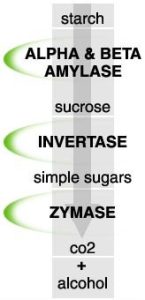Section Links
 First, starch has to be broken down into sugar. The sugar then has to be broken down into simple sugars to allow yeast to react with these sugars during the process called fermentation (rising).
First, starch has to be broken down into sugar. The sugar then has to be broken down into simple sugars to allow yeast to react with these sugars during the process called fermentation (rising).
Starch is made up of many glucose units joined together but yeast can’t digest starch unless it is broken down into glucose units.
Enzyme digestion of starch can occur in two main ways by damaging starch mechanically, or by gelatinising it.
Damaged starch sounds as if it has been ruined for baking, but this is not true. It simply means that some starch granules have been crushed, broken or chipped during the milling process. In fact, some starch damage is highly desirable in bread flour and 6% damage (of the total quantity of starch present) is considered about right.
Several enzymes are required in dough to convert starch into simple sugars that yeast can feed on. This is a complex process and involves the enzymes alpha and beta amylase. If these enzymes are present they can digest starch and provide the sugars for yeast fermentation.
Starch exists in two different forms – an unbranched chain form called amylose and a branched form called amylopectin. Enzymes that digest starch are called amylases.
There are two important enzymes that digest these types of starch alpha-amylase and beta-amylase.
Alpha-amylase
Dough must contain some alpha-amylase to digest the amylopectin part of starch, but if dough contains too much of this enzyme it can completely liquefy starch. Alpha-amylase attacks starch practically anywhere along its chains, producing smaller chains of various lengths. These chains can contain one unit (glucose), two units (maltose) or larger units called dextrins that contain many glucose units. In a dough, beta-amylase can then digest these dextrins into maltose.
Beta-amylase
Cereal grains and flour always have an adequate supply of beta-amylase that can digest amylose completely into sugars. Beta-amylase attacks amylose chains and breaks them into molecules of maltose. Maltose is a disaccharide containing two glucose molecules.
Beta-amylase will also start digesting amylopectin from one end of the molecule but it cannot break the branches so digestion stops whenever it comes to a branch. Therefore, beta-amylase digestion of starch results in a mixture of maltose and larger dextrins. Yeast produces the enzyme maltase to break maltose into glucose molecules that it can ferment.
Once the starch has been broken down into these simple sugars, other enzymes in yeast act upon simple sugars to produce alcohol and carbon dioxide in the bread making step called fermentation. Sucrose (sugar) can’t be fermented directly by the yeast enzyme, zymase. One of yeast’s other enzymes, invertase, must first digest sucrose into glucose and fructose. The yeast enzyme, zymase, then ferments these sugars.
